Biology Term 4
1/79
Name | Mastery | Learn | Test | Matching | Spaced |
|---|
No study sessions yet.
80 Terms
endemic
species only belonging or native to particular people or country
ecological organisation levels in ascending order
Organism→Population→Community→Ecosystem→Biosphere
population
group of organisms of same species in particular geographical area at partiuclar time
research focus on size and how it changes over time
species
group of organimsms with similiar characterisits (similiar anatomical characteristics, common gene pool)
can interbreed to produce fertile offspring - different species cant
compete with each other for researches
community
sum of all living organisms of different species,or biotic factors, in common geographical area
different sepceis are interdependent , exhibit range of interactions
reseach focuses on interactions between species (factors effecting and consequences if removed from community)
ecosystem
interaction of living (biotic) factors (e.g. communities of organisms) and non livign (abiotic) factors (e.g. physical surroundings)
research on analysing how nturiwnts and energy are stored and how they flow thru ecosystems
biosphere
highest level of ecological organisation
global ecoystem or zone of life on earth
made up of all ecosystems on earth
biotic and abiotic factos
biotic - living compounds of ecosystem
abiotic - non-living physical componenents
intraspecfic and interspecific interactions + 3 types of interactiosn
intraspecific - interactions between members of same species
interspecfic - between memebrs of different species
competition, predation, symbiosis
competition
compete for same resources (e.g. light, oxygen, nutrients, prey, space, sexual partners)
no 2 species have identical requirements - overlap is where there is competition
outcome generally has negative effects on weaker competitors
more intense amongst members of smae species
outcompeted species must adapt to remaining available resources or become extinct
significant drive of natural selection and evolution
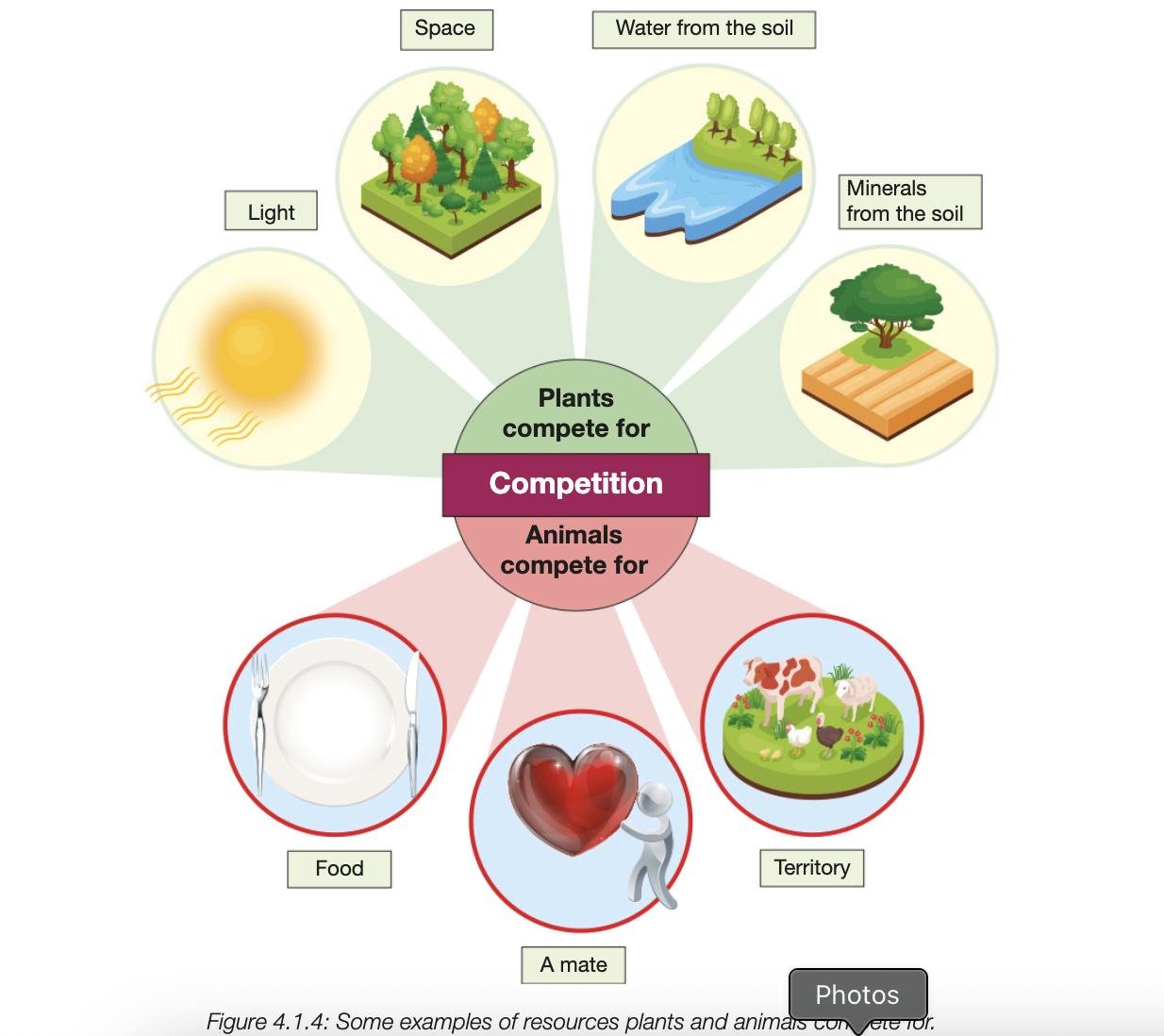
predation
one organism (predator kills and consumes another or parts of it (prey)
generally occurs between different species, when same sepcies it is cannibalism
cannibalism helps species survive times of limited resources
affects no of organisms in population, biodiversity of community, evolution of organisms involved
Herbivory
consumption of all or part of photosyntehtic organism, generally plant, by animal
can result in death of photosyntehtic organisms but nto always
photosynthetic organisms are producers in most food chains
herbivores and plants drive adaptations in both species
herbivores - digest and extract nutrients from plant matter plants - physical and chem defences
symbiosis
distict relationships between organisms of two different species
three categories - mutualism, commensalism, parasitism
mutualism
both species benefit
e.g. on image

commensalism
one species benefits, other in unaffected
e.g. on image

Parasitism
one benefits, other is harmed
invovles organisms called parasite harming organism called host
e.g. on image

decomposers
heterotrophs that extract energy from remains/waste products of organisms from all trophic levels - break down dead matter and recycle nutrients - wihtout, dead organisms and matter build up
trophic levels, consumers
trophic level - relative position of an organism in the food chains
1st - producer, synthesises own energy-rich compounds (e.g. plants)
remaining - heterotrophs, feed on producers and other animals consuming producers, consumers
first consumer in fodo chain - primary consumer - 2nd trophic level
seconadry consumer - eats primary consumer, 3rd trophic level
consumer at top of food chain - apex predator, no natural predators
food web - many linked fodo chains, more accurate
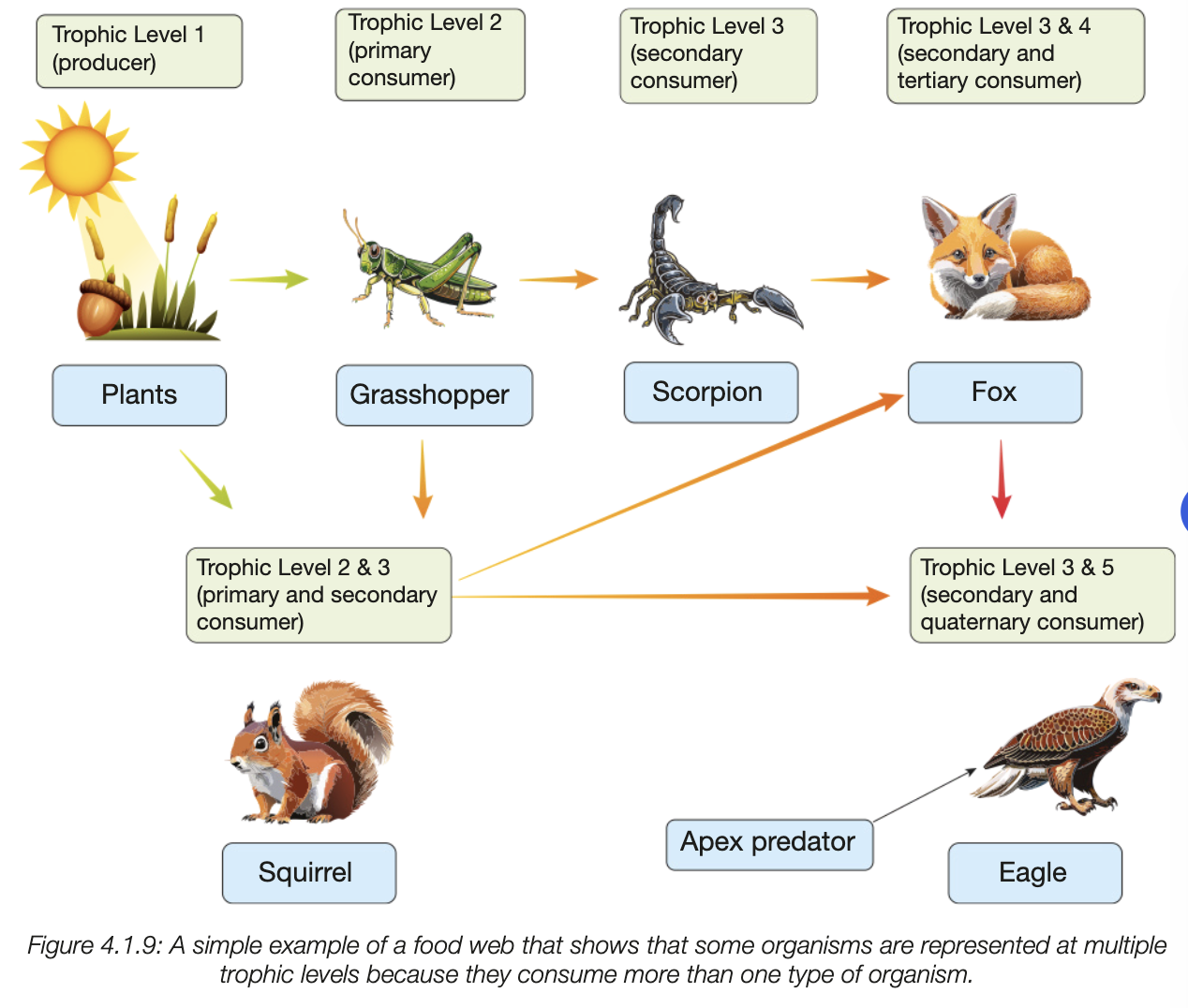
biodiversity
varity of living things on earth (genetic info, ecosystems).
3 different levels - genetic, species, ecosystem
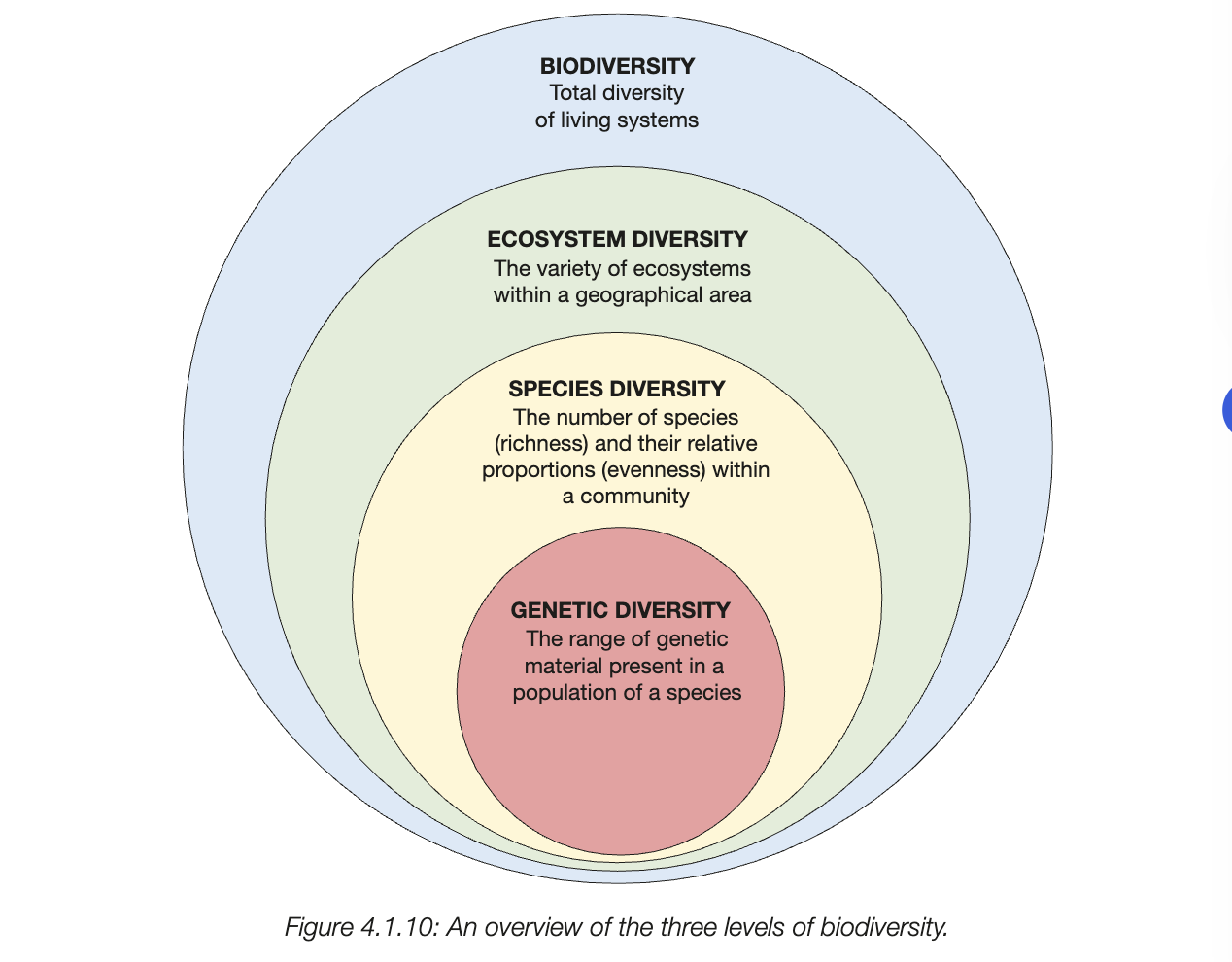
genetic diveristy and gene pool definitoin + effect
diversity within species
more individuals in the population, greater genetic diversity
different populations generally have different genetic compositions (gene pools - sum of all genes of individuals in population)
llarge gene pool → more likely to survive changing environmental conditions - increased chance some individuals have genotytpe surviving changing conditions
better adapted to new environment conditions (selection pressures) are more liekly to pass suitable traits to offspring
less gentic diversity can result in one environmental changes wiping out individuals - natural selection
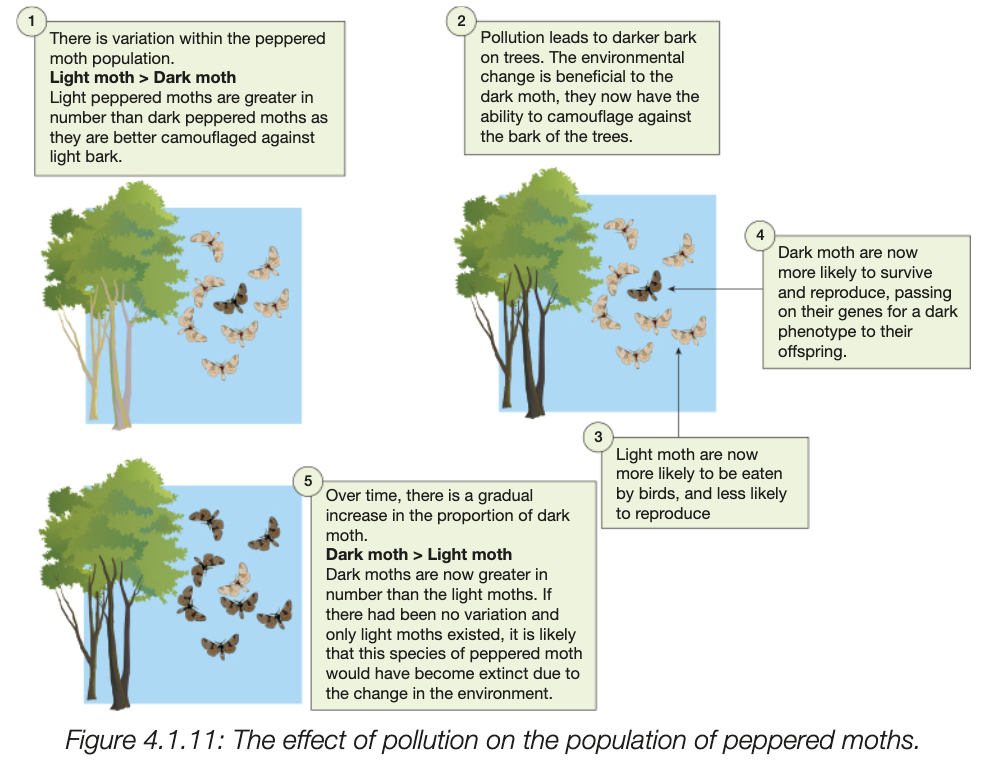
genetic drift
random changes in the gene pool of the population
small populations are more susceptible to genetic drift
bottleneck effect - random loss of genes due to environmental events (natural disasters, e.g. bushfire)
large reduction in genetic diversity because population members are killed - survivors are necessarily better adapted to the environment
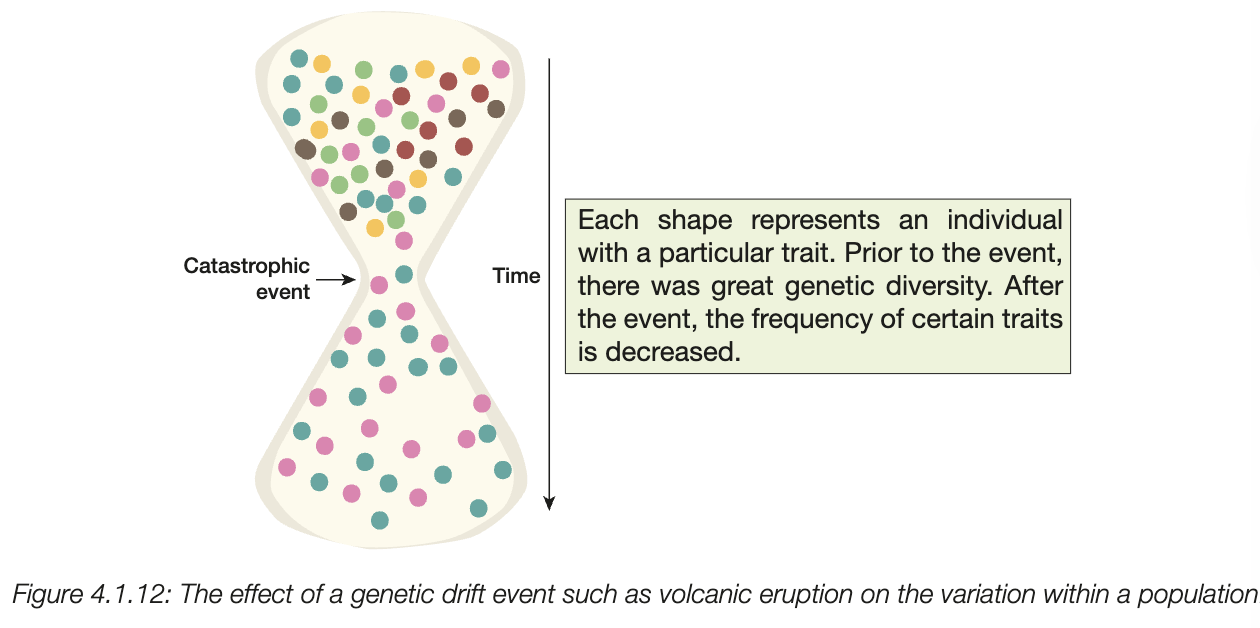
species diveristy
variety of species within community
essentail for perpetuation of the community - addng or removing species changes entire ecosystem as relationships and interactions between factors is removed
ecosystem diversity
variety of ecosystems on earth
hels regulate chilmati conditions, recycle nutrients, maintain soil quality, maintain balance in atmosphere
essential for perpeutation of life
taxonomic levels/taxa (singular - taxon) in descending order + how they are based on
based on shared characterisits as well as molecular similarities (domains highest, most general, species lowest, most specific)
as they are smaller, become more sepcific and contian less sepcies
species closely related have greater no of same taxonimic levels
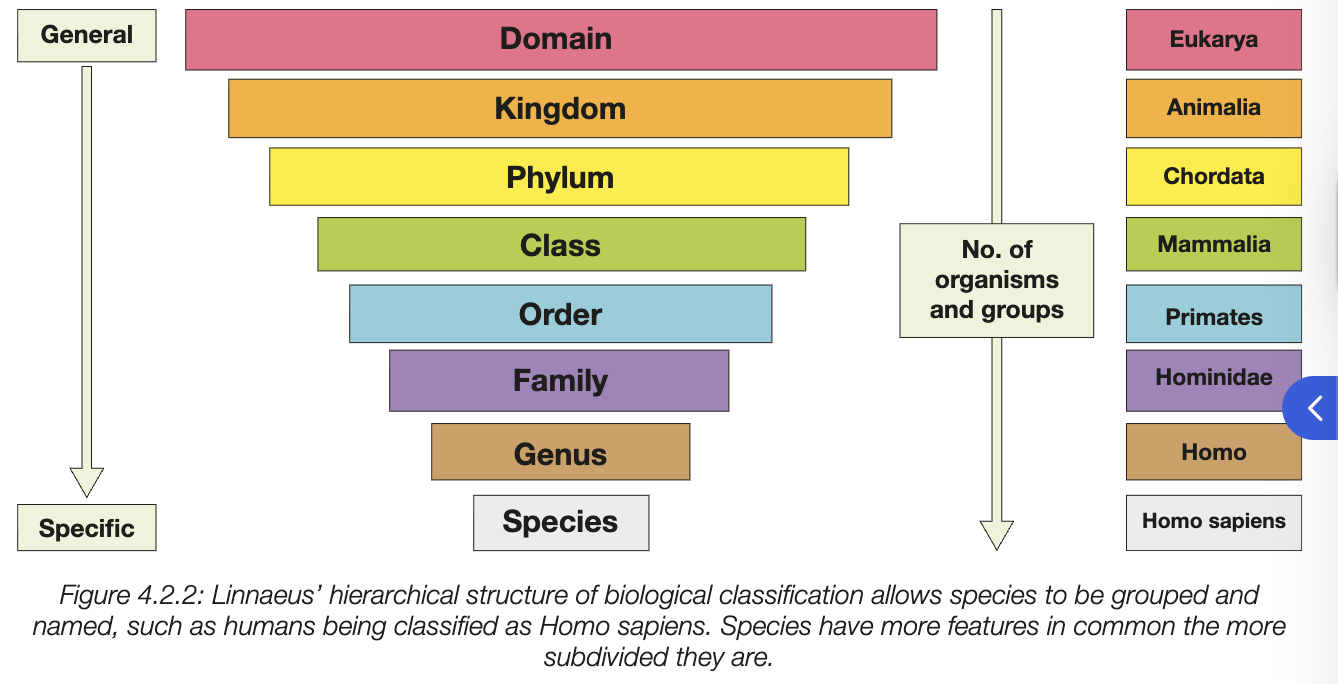
binomial system of nomenclature
every species given scientific name with two parts
first part - genus (generic name) - capitalised (e.g. Homo)
second part - species (specific name) - lower case (e.g. sapiens)
binomial names are latin - type in italics or underlined if handwritten
things with same genus different species are closely related but not same
modern hierachial strucutre of biological classification + characterisits used to identify kingdoms - MEMORISE TABLE
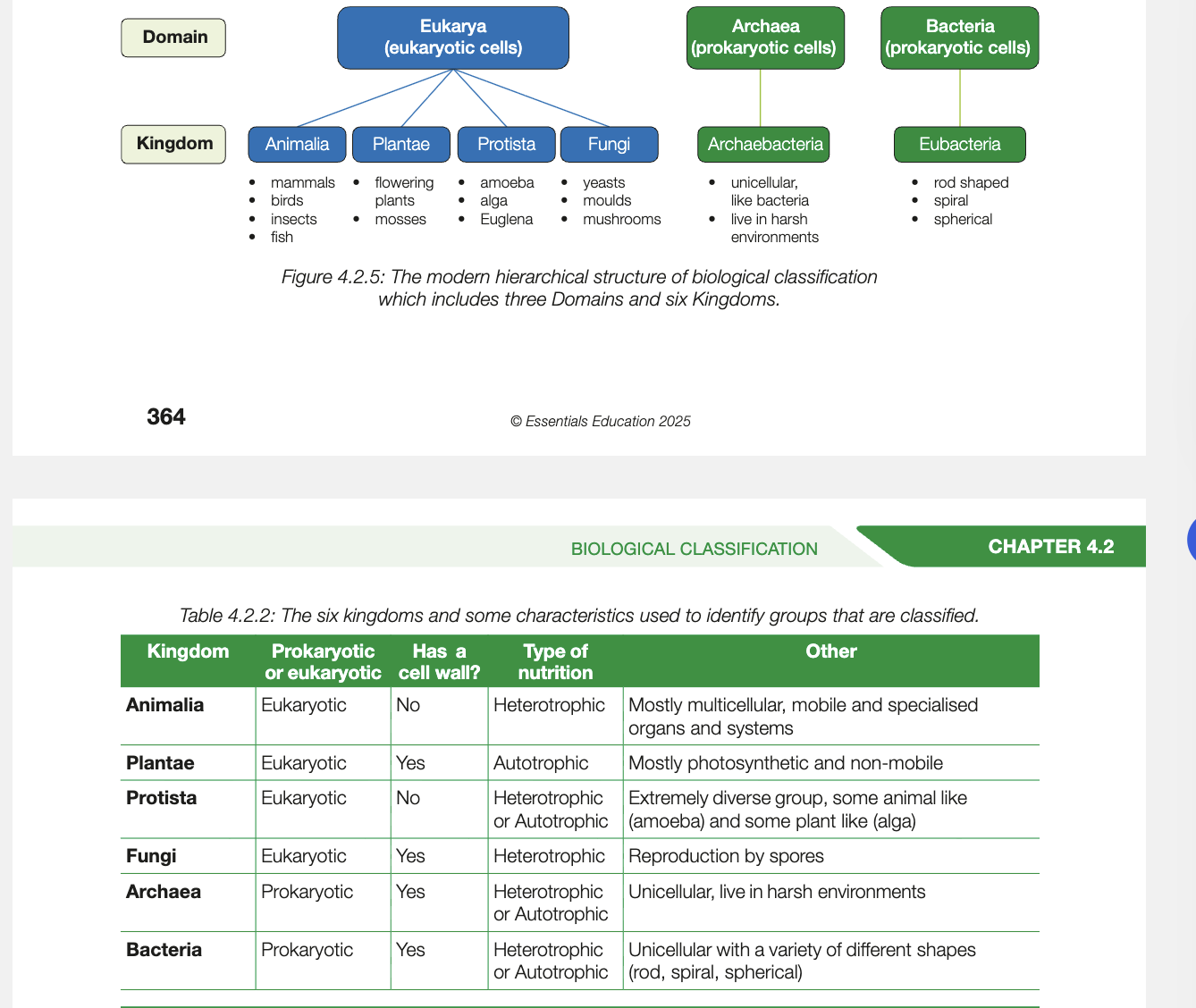
limitations of species definition (organisms of same species can interbreed to produce fertile offspring, diff cant)
reproductive isolation doesnt occur instatnly - two populations may have different physical features but may e able to interpreed still
species definition cant be applied to asexually reproducing species
could be lack of data to apply this species definition to particular species - could be lack of funding, species are extincy, interbreeding behaviour not documented
basis of classification - physical features and reproductive strattegies
physical features are expression of genotype and environment, tehrefore organisms with fimilar features are often closely related- can be used in classifying range of diff organsisms
some species reproduce sexually, others asexual - used to classify range of diff organisms (e.g. mammals - 1 of 3 repdoductive strategies so the groups are diff)

basis of classification - molecular sequencing
helped increase accuracy of biological classification by examining DNA sequences and prtein sequences
comparing DNA (made up of long sequence of bases) and known gene sequences, inferences can be draft regarding common acnestors and degree of relateness
limitation - cannot be used on extinct species as dna and proteins are degraded and cant be sequenced reliably - species that dont aerobically respire cant be compared using aminco acid sequencing of cyochrome c protein
dichotomous key
uses series of choices to clearly identify given speices
presents series of mutually exclusive choices ased on particular characteristics
to identify species pair of statments need to be applied, one is applicable, continues until correct statement leads to identity of species
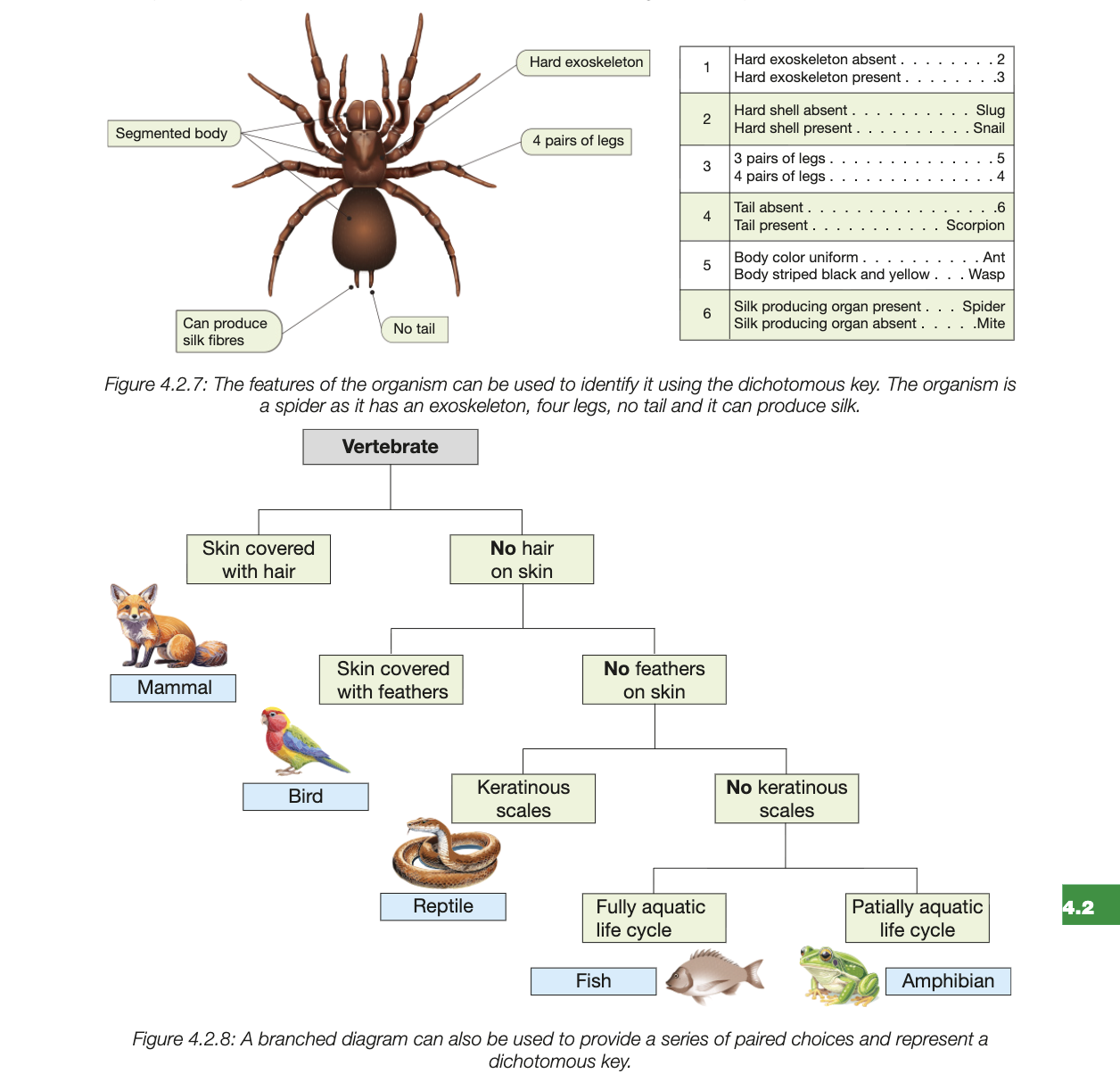
reproductive isolation (maybe add more to this)
attraction of mates - pheramone chemicals released by one of the sexes - only attract members of their own species
reproductive barriers foring isolating boudnaries around closely reltaed speices can be divided into two groups - prezygotic and postzygotic isolating mechanisms
pre-zygotic and post-zygotic mechanisms
PRE ZYGOTIC
any mechanism occuring before gametes fuse to make zygote
e.g. diff matinc calls and rituals, specific pheramones, difference in flower shape/genitalia, different seasons/times for reproduction, inability of sperm to survive female reproductive system
pollen tubes unable to grow in ovules in a flower
Post Zygotic
any mechanism after gametes fuse to form a zygote
e.g. zygote fails to develop (miscarraige), young fails to reach sexual maturity, offspring live but are infertile

adaptation
feauter of organims increasing fitness (probability of surviving and reproducing in its haitat) - inherent
generally 3 types - strucutural/anatomica, physiologica/functional, behavioural
adaptation is feature produced by natural selection for current fucniton in specific habitat
reasons for adapting - find nutrients, adjust to temp of habitat, dehend from herbivores or predators, increase reproducive chance, escape dangers, adjust to change sin habitat
PENTADACTYL LIMB! EDIT AND ADD THIS!
structural/anatomical/morphological adaptations
physical body feature sof organism helping them survive
genetically inherited, shaped by natural selection which acts on traits passed onto offspring
do not develop during one organisms life but over many generations, increase biological fitness of organisms
E.G.
large earts of bilby/desert animals increases surface area to emit more heat and cool animal
artic fox has small ears to reduce heat loss and stay warm
streamline shape of dolphins help move in water
long giraffe neck lets it reach leaves high in treetops
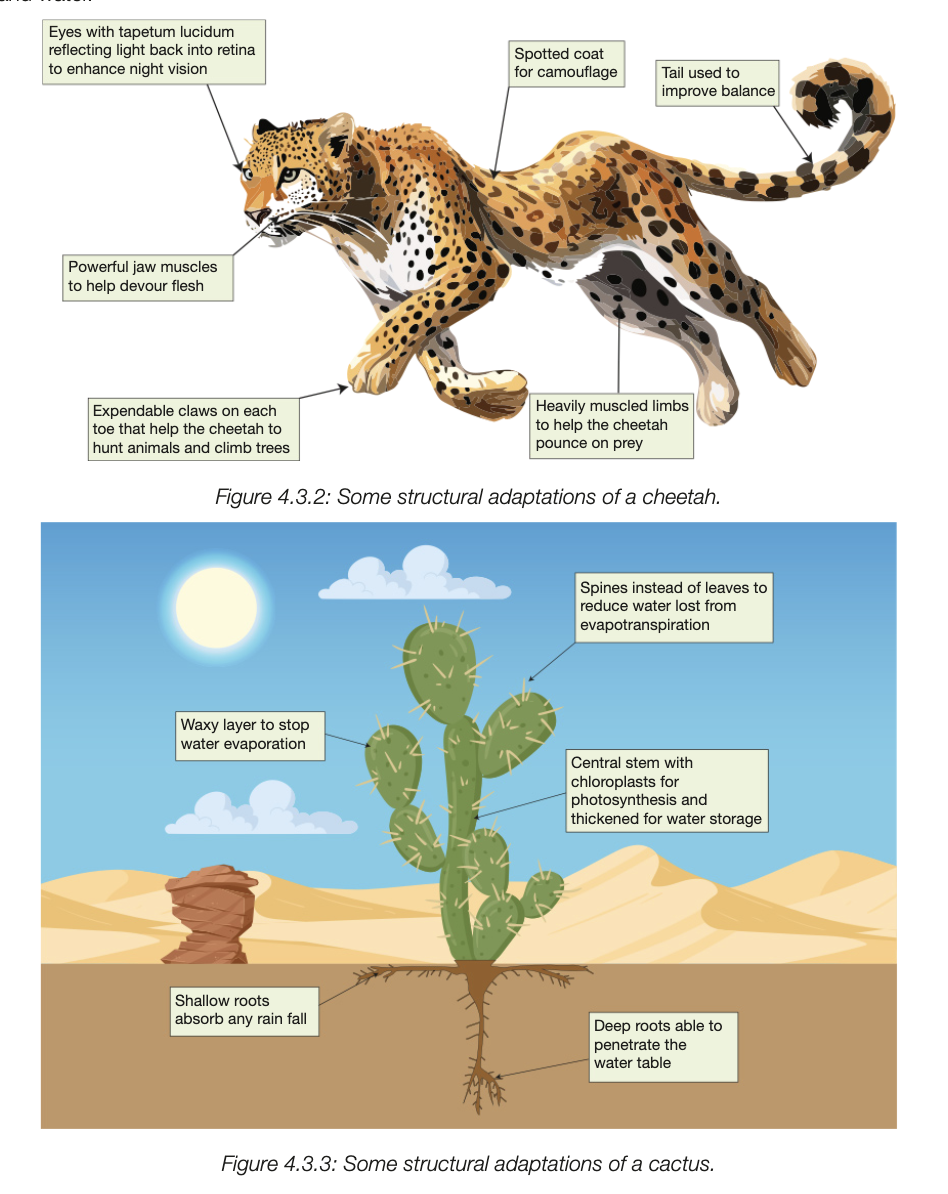
physiological/functional adaptations
geerally based on features that arent visible
generally associated w metabolic processes, usually based on body chemistry and other processes that enhance survival and reproductoin
E.G.
desert animals excrete concnentratd urine to conserve water
secretion of tozins by plants to assist defence
sense of smell of wolves assist huntings
oxycoin horomone in humans promote bonding, breastfeeding increases oxytocin release in both mum and baby

CYTOCHROME C PROTEIN
cytochrome c is protein necessary for aerobic repiration in virutally all living organisms
varies from one species to another, dregree of similarity in amino acid sequences between species indicate closeness of evolutionary relationsships
e.g - humans and chimpanzee match at all 104 amino acid postionts, indicates very close evolutionary relationship

behavioural adaptations
associated w paters of activity or behaviour
something animal does in repsone to external stimulus, increases chance of survival, innate OR learnt
E.G
desert animals are more active at night as conditions are cooler
courtship rituals by birds or mating calls of frogs increase chance of finding mate and reproducing
migration of humpback whales to colder waters to feed on krill, warmer waters to mate and reproduce
opossume play dead when confronted by preadtor
photosynthesis
photosynthetic organisms can capture and transform sunlight into chemical energy (glucose)
chemical bonds holding co2 and h2o molecules together are broken, atoms are rearranged to make glucose and some oxygen
primary producers
producers of chemical energy, all other species in food web rely on them for energy
use glucose for daily energy needs, can transport excess into storage sinks that animals can consume
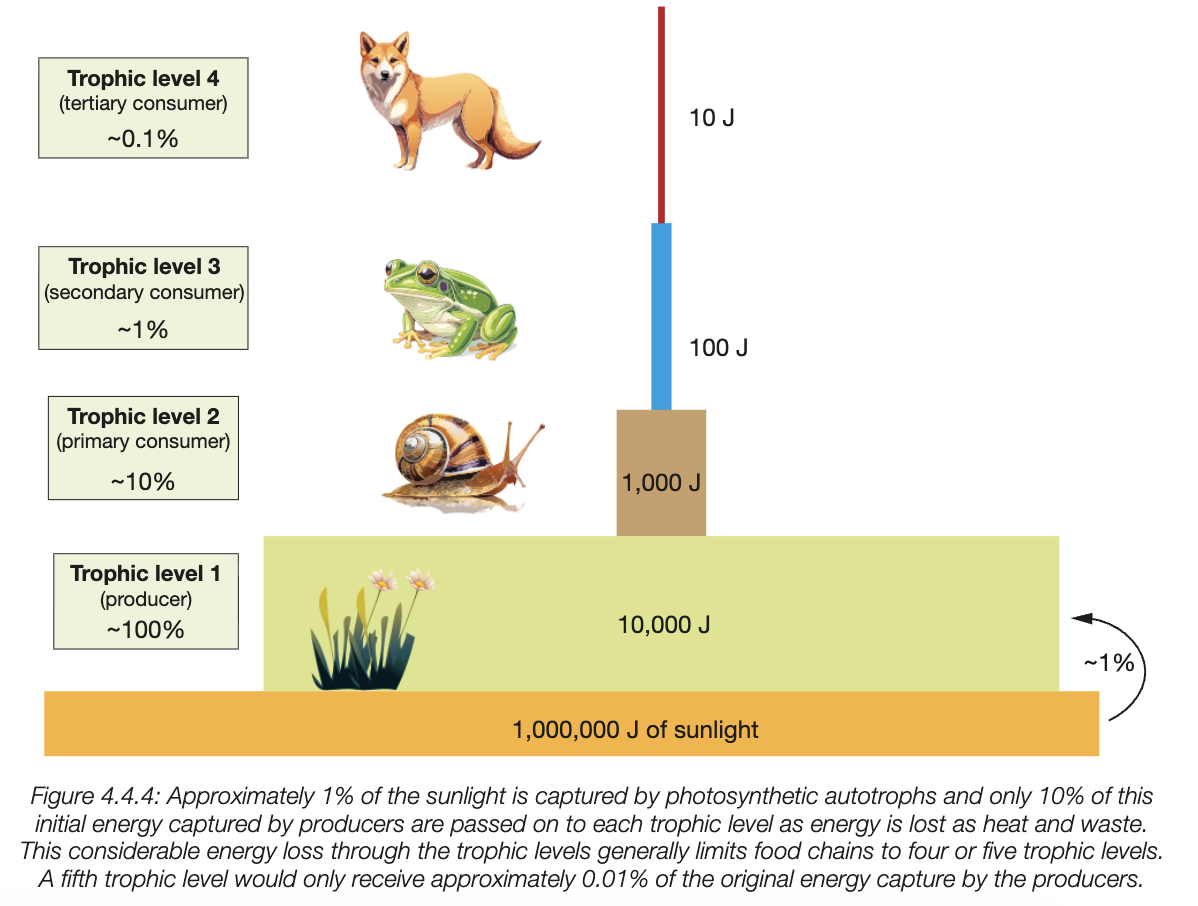
trophic levels in food webs/chains (energy transfers stat)
energy is transferred from one level to another by consumption
first trophic level is always primary producer/autotroph, remianing are consumers (heterotrophs)
approximately 90% of the obtained energy is lost as heat and waste at each trophic level
only approx 10% of energy orginally obtained by trophic level is avaialbel for next trophic level through consumption
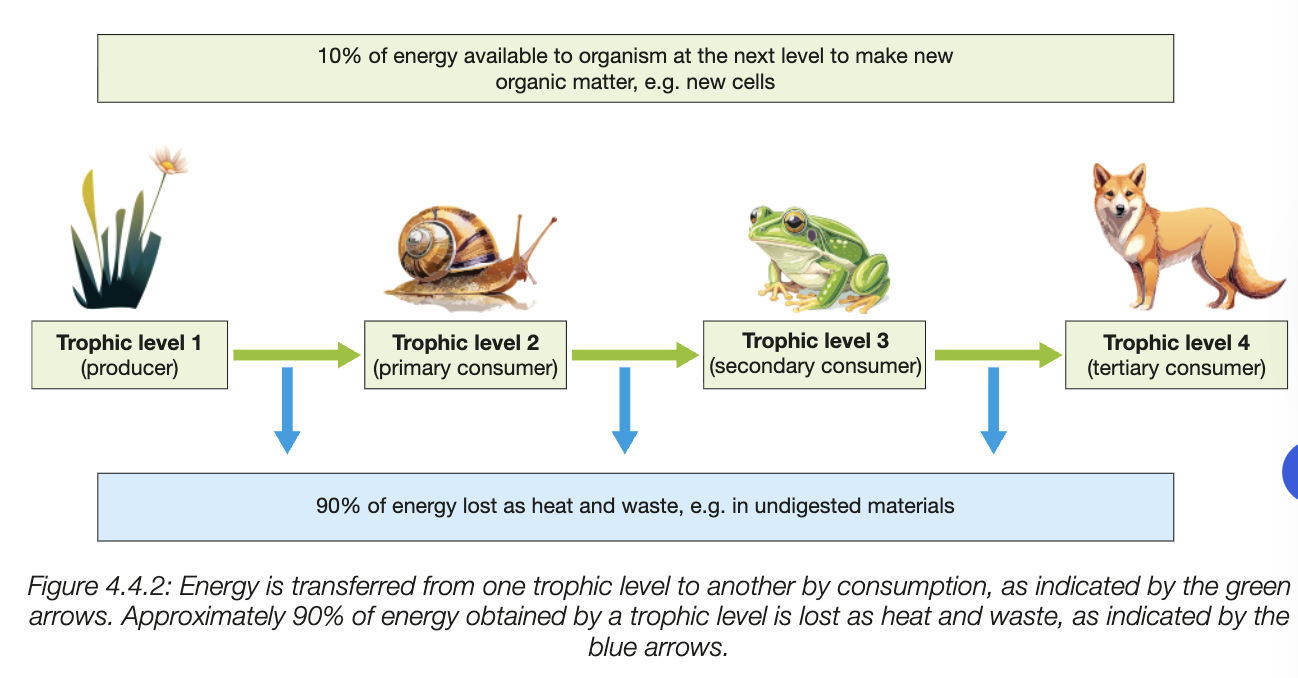
inherited adaptations vs learnt adaptations
Inherited adaptations are passed on from parents to their offspring in their genes and can be structural, physiological or behavioural. Some behavioural adaptations that increase the chance of survival can be learnt throughout life by some organisms. These adaptations are not coded for by genes
dead organisms and wastes broken down….
by decomposers - extract energy from remianing organic mamter and respire releasing heat back to environemtn
biogeochemical cycles (why and what interactiosn, tissues made of, decomposers)
chemical elements and simple nutrient molecules needed by organisms are cycled within ecosystems
involves interactions between biotic and abiotic components of the ecosystem
matter is neither created nor destroyed - matter must be cycled from abiotic environment through living organisms and back to the abiotic
involved decomposers - feed on dead and decomposing, metabolic actions break down organic material (e.g. carbs, protein, nucleic acids, lipids) into inorganic substances
return to soil, increases soil fertility (abiotic component) to be incorporated back into the new plant (biotic component)
mail elements making tissue - carbon, oxygen, nitrogen, sulphur, phosphorus, potassium, calcium

water cycle
water form oceans lakes etc evaporate and turn into water vopour, rise into atmosphere
transpiratoin form terrestrial plants also release water vapour
vaporu cooles and condenses into clouds (condensation)
water falls back to earth as precipitaion
some of it flows over land as runofff and reutrn to bodies of water, some infiltrates ground and replenishs groundwater
snow and ice can also melt and runoff or pelocate to groundwater
plants and animals do their thing wtih water
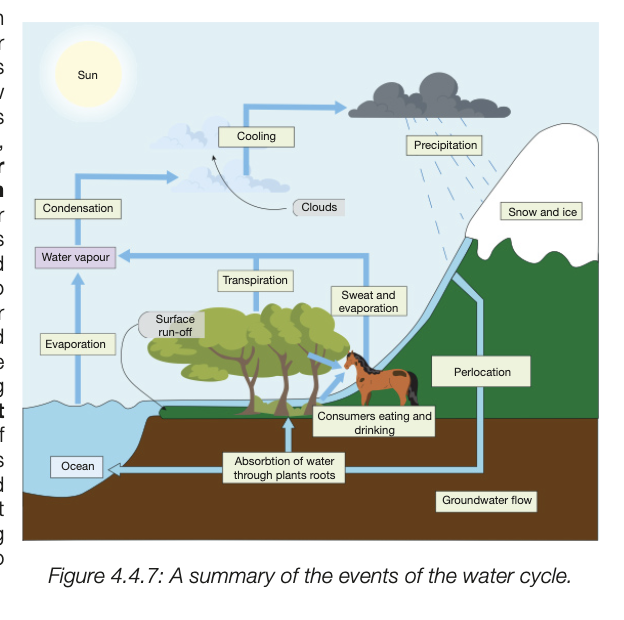
carbon cycle
CO2 is absorbed from atmosphere by plants (photosynthesis) and becomes glucose
glucose is used as energy source for cellular respiration, releases Co2 or converted into other organic matter
animals consume plants, transferring carbon thru food chain
decomposition of dead organisms and waste releases carbon back to soil and atmosphere
can be stored for long periods in carbon pools, carbon fluxes is movement of it beteeen them
e.g. carbon sequestriatoin (admospthere to ocean), combustio of organic matter (carbon sequesration)

nitrogen cycle
nitrogen fixation - bacteria in soil or root nodules of legules convert atmospheric N to ammonia, taken by plants
can also be fixed thru lightning or inductrial processes
once in soil, nitrification - other bacteria convert ammonia into nitrites and then to intrates, absorbed by plants
plants consumed by animals, transferring it through food chain
dead animals are decomposed by bacteria and funfi, break down organic nitrogen compounds, return ammonia to soil (ammonification)
dentrification - specialised bacteria convert nitrates back to nitrogen, release itno atmosphere and complete cycle
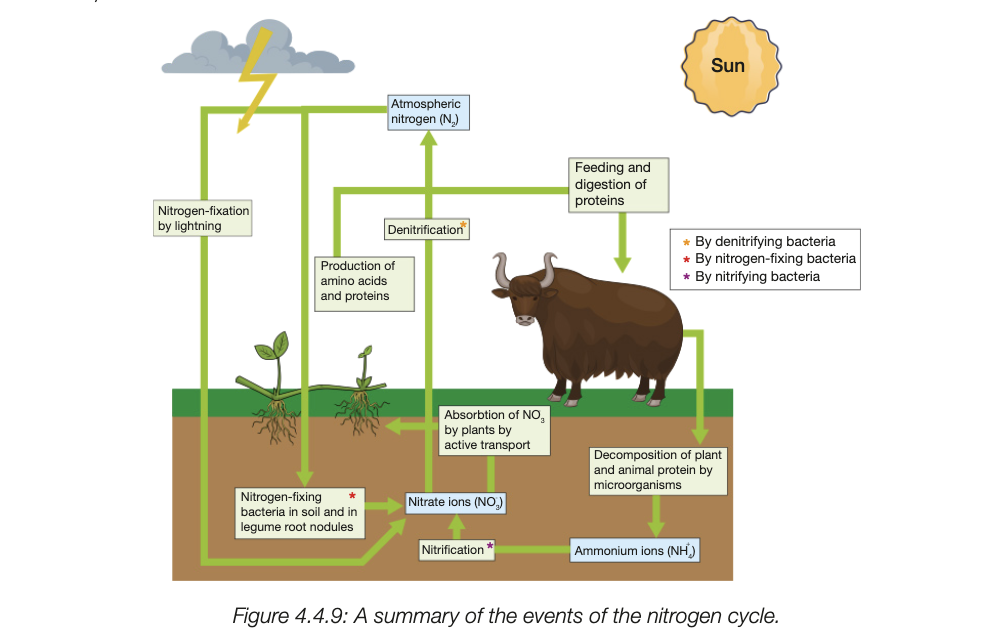
phosphorus cycle
phosphoirus mainly found in rocks and sediments
wearthering and erosion of rocks, releases inorganic phosphate into soil and water
plants absorb phosphate through rooots
plants have evolved mycorrihazae - symbiotic reltaionship between fungi adn plant roots, fungi enhance plants ability to absorb water and nutrients, plan give sfungi carbs from photosyntehsis
animals consume plants, obtaining phosphorus molecules into tissues, contineu down food chain
dead animals decomposed by organic matter, return phosphorus to soil as inorganic phosphate
leached into water, settels and forms sedimentary rock and restrats cycle through geological uplift
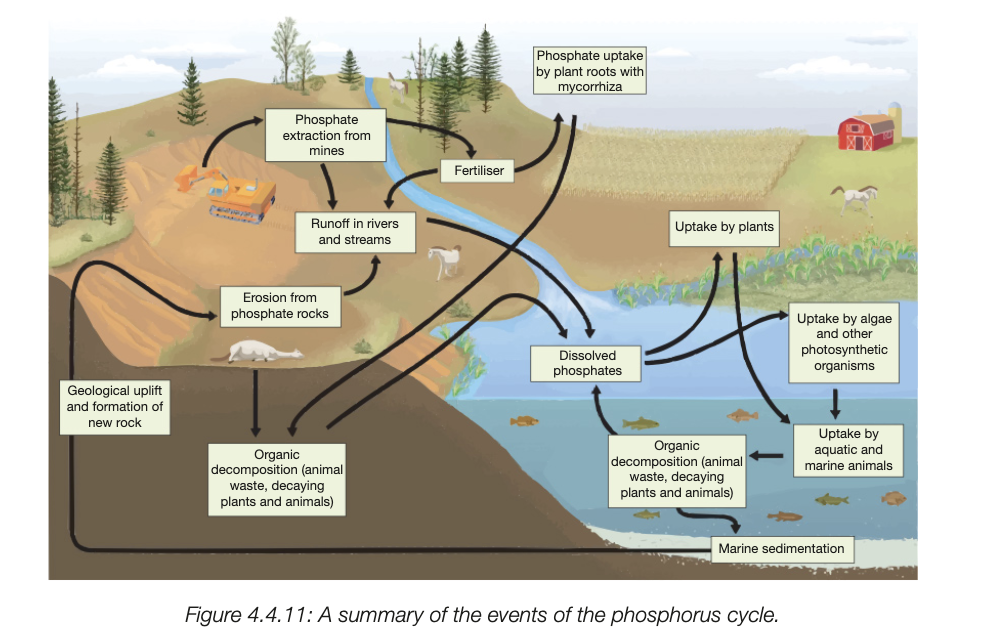
how is composition of community determined
by environemnta conditions - e.g. water avaialability, soil nutrients, temp, fire frequency, salinity
organisms adapt to their niches
SCLEROPHYLL FOREST ADDD
rainforests
dense, biodiverse
primarily in tropical regions
high rainfall, rich vegetation
major carbon sink, regulate atmosphere and climate
e.g. tropical, temperate, decidous, mangrove, montane, mixed, boreal
tundra
cold, treeless, high mountains and arctic
permafrost, minimal vegetation
specialised plants and animals well adapted to extremely cold conditions
store frozen methane, crucial role in carbon cycle
e.g. arctic, antarctic, alpine
desert
arid, sparse rainfall, extreme temp fluctuation and limited vegetaton
plants are well adapted to store and retin water, animals are noctornal or burrowers
e.g. hot and dry deserts, demi-arid ceserts, coastal deserts, cold deserts
freshwater
marine, not salty
diverse range of equatic life
regualre water cycles, provide essentail resources to populations
e.g. rivers, streams, lakes, ponds, wetlands, estuaries
ocean
cover most of earths sources, variety of habitats
coral reefs are one of most biodeiverse ecosystems
vital role in regulating climate, supporting marine biodiveristy, corviding resources such as ozygen water and food
e.g. open ocean, coral reefs, deep sea, kelp forets
grasslands
open, explansive, dominated by grasses and few treest
vital role in carbon storage, soil health, agricutlruer
found in tropical and temperate zones
e.g. temperate, savannas, steppes, pampas
alpine
high altitude, cold temp, strong winds, short frowing season
support specialised animal species adapted to extreme cold
plants are hardy grasses, shrubgs, mosses
e.g. apls, andes, himalayas, rocky mountains
compare tropical rainforest, clerophyll woodland, australian hot and dry desert, and freshwater pond
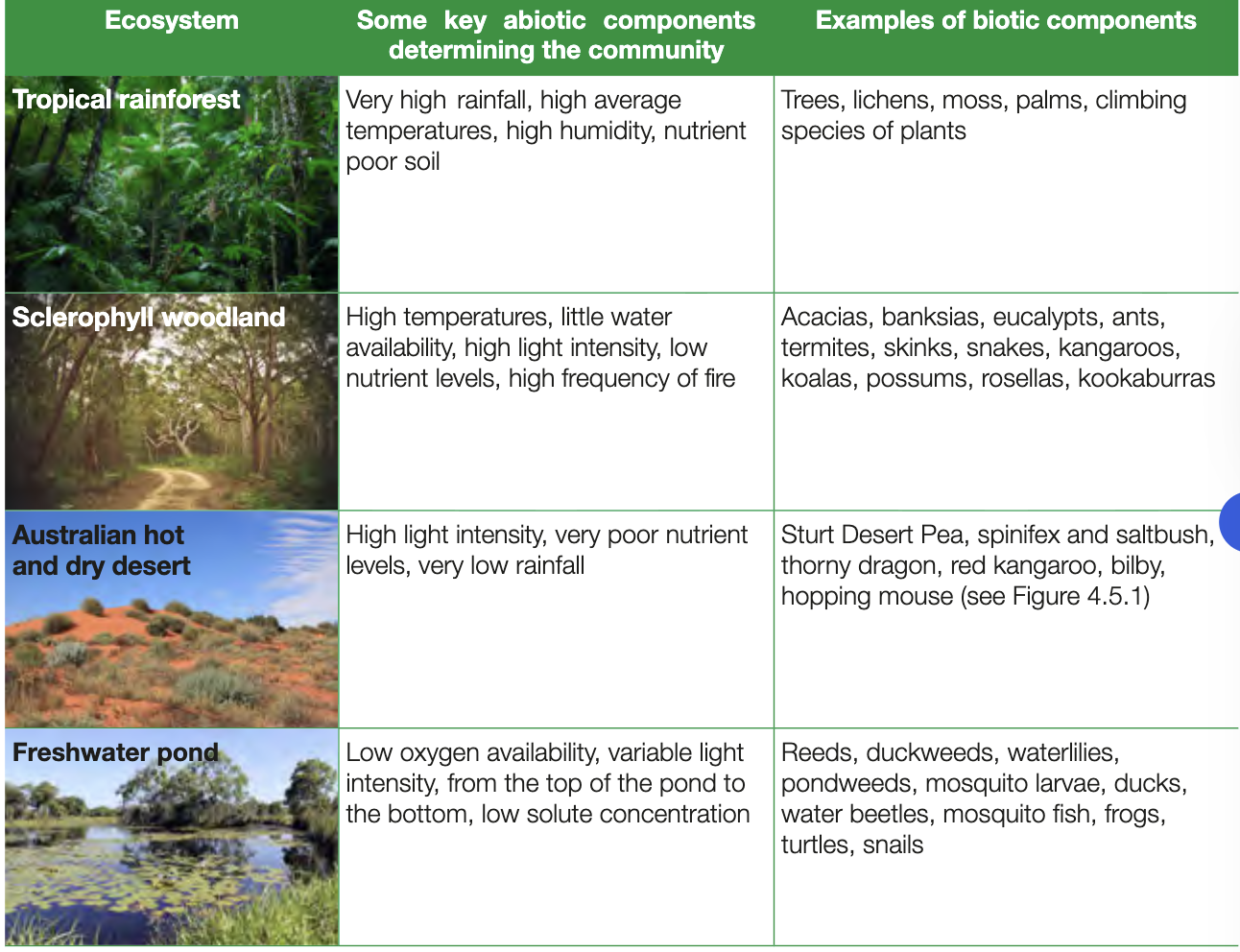
adaptations for abiotic components: low oxygen levels, low solute concentrations, high viscosity of water, low light intensity

ecosystem stability
persist if can capture, transform, and trasnfer energy, cycle essential nutrients and elements. rich diversity = resist change and remian intact
stable ecosystem - maintained over long periods of time
unstable ecosystems - now species diveristiy, more vulnerable to change
ecological niche
specific role/function organims plays within ecosystem - defined by living and nonliving factors
how a spceies fits into its habitat and ineracts with it
act as selection pressures, ensure most suitable individuals in species survive to reproduce
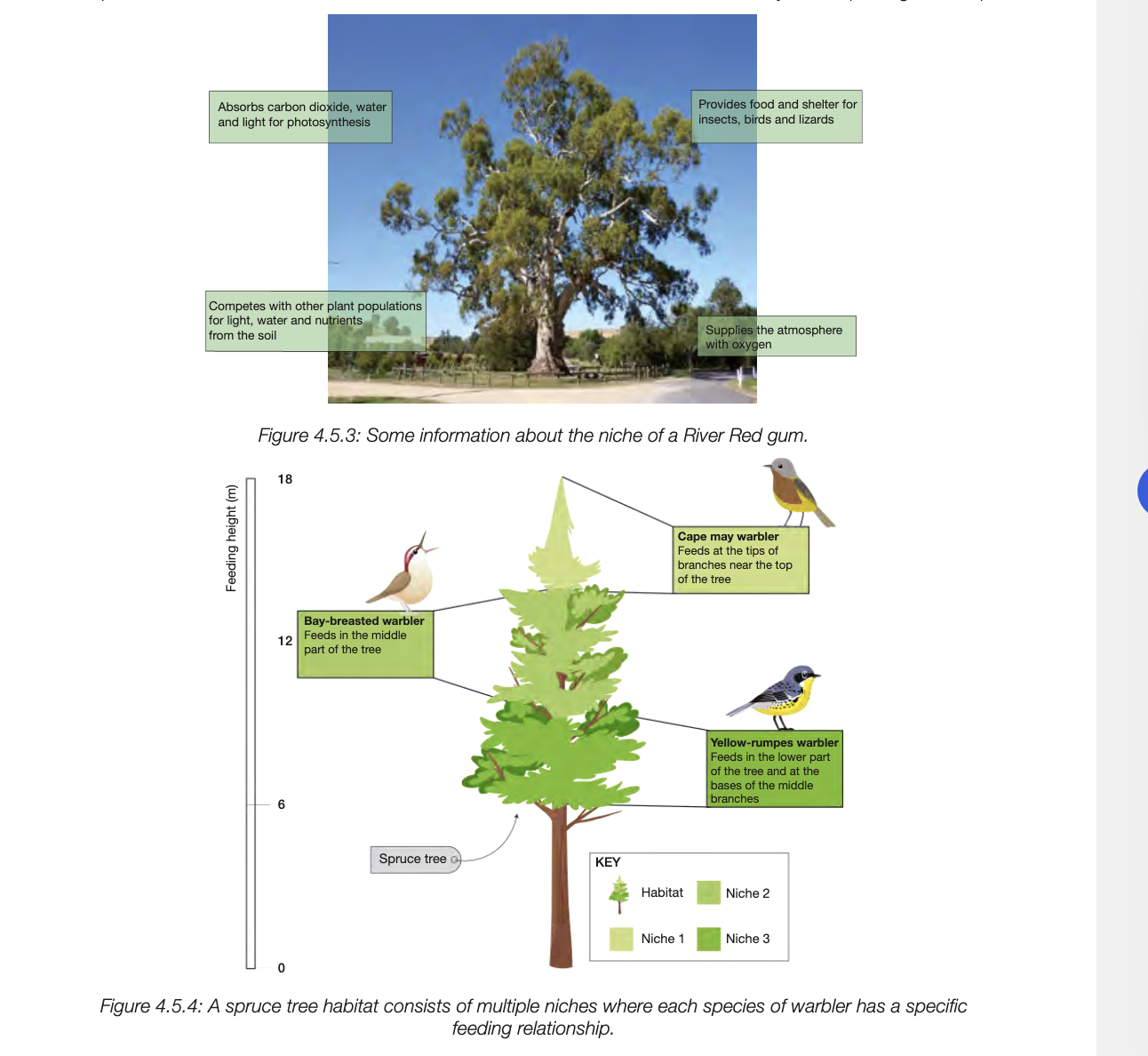
niche overlap
similar niche results in overlap
niche overlap graph shows it - small zone, less competition, big zone/identical/similar niche, high competition
high overlap → one population goes extinct
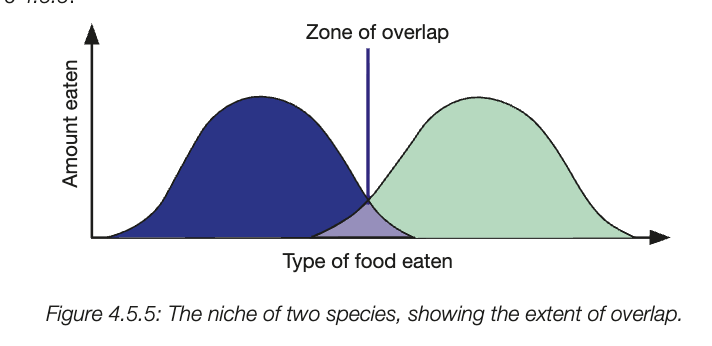
fundemental and realised niche + chtlamus and balanus things example
fundemental niche - full range of environmental conditions and resources an organism can theoretically use
realised niche - portion of that range the organism actually occupies due to competition, predation, or other limiting factors
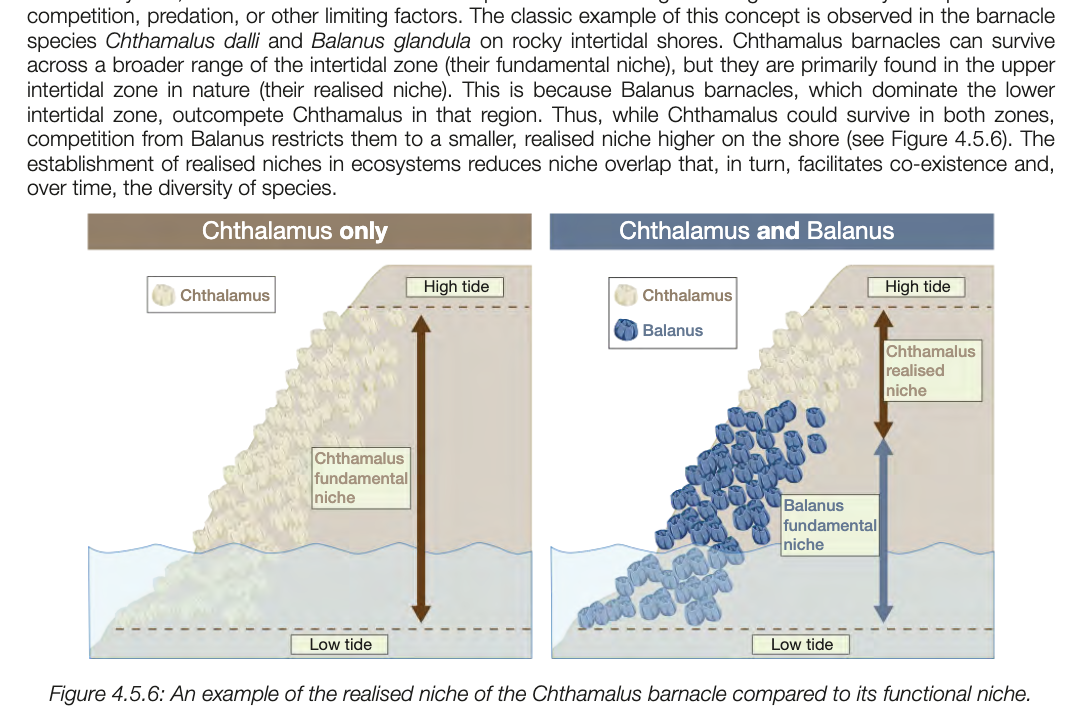
zonation
spatial distributon of a species/communities across distinct envrironmental gradeitsn
influenced by variying abiotic factures - create diff habitats across zones
within the zoens speciesi inhabit (based on ability to survive and thrive), organisms fill their niches
illustrates how both habitat preferences and niche roles drive distribuition and strcutre of ecosystems
stratification and layers of rainforest
vertical layering of habitats within an ecosystem
creates disticny layers - each with own set of abiotic conditions, influencing types of species that can inhabit each layer
each layer provides diff habitats that support specialised organisms adapted to those specific conditions
within each layer, organisms occupy ecological niches
forest floor, understory, canopy, emergent layer

keystone species
play a crtiical role in maintaining strucutre, balance, and health of ecosystems )greater affect of stability of ecosystem than others)
presence or absence has a disproportionately large impact on the environment and variety of species in it
infleuncce factors (e.g. population control, resource availability, habitat structure) to help regulate ecosystem dynamics
without, ecosystems become destabilised
loss of keystone species (sea otters)
changes ecosystems as certain other species will also be affected
sea otters ear urchins, which eat kelp
klps neach provides marine organisms with food and shekter and oxygen for aerobic respiration
larger sea otters, less urchins, more kelp resulting in large well develped foresets
decrease in ppulatino size of otters (increased predation by whales) causes other populations to decline, more urchin, less kelp
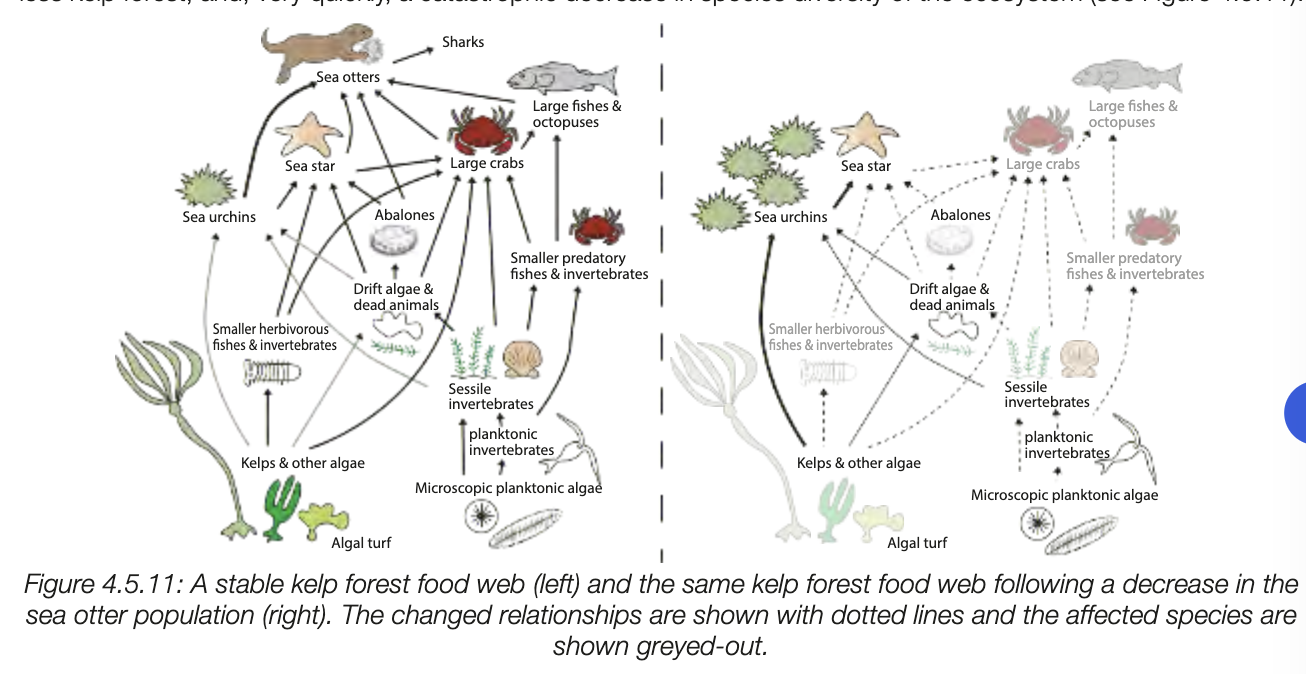
daily change impact on ecological change
day and night affect the abioitc components of an ecocysstem - change during it
changes in light intesnisty, temp, humidity
nocturnal animals are also a change
seasonal change impact on ecological change
cyclic changing of seasons results in changing weather patterns in ecosystems
caused by revolution of earth around the Sun, resutls in 4 distinct seasns
affects abitioc factors like temp, rainfall, soil moisture, evaporation rates, flwoing rivers, snow cover
changes in abiotic factors impact biotic factors and affect type and amount of food available
winter _> days are shorter, temp decreases
polar regions need alternative food sources, move to warmer places, or hibernate
abiotic in spring supports the reproduciton of plants and animals
size of populations of species can change so much that community visibly changes
long term ecological change + ecological succession
occur if abioitic and biotic components oc ecosystem are significantly altered, such as colonisation of new species or natural disaster or humans
may change abitioc and biotic components sm that conditions are more suitable for other speicies
slowly and permamenyyl changes mix of species in ecosystem
unidiractional type of change is ecological succession

primary succession
Primary succession starts in lifeless areas without soil (e.g. bare rock, retreating glaciers, volcanic islands).
Example: Galapagos Islands off the coast of Ecuador. (volcano underdasea)
Wind-blown spores of lichens and mosses settle in rock crevices and begin colonisation.
Dead lichens and mosses mix with eroded rock fragments to form simple soil.
Soil becomes stable and nutrient-rich, allowing grasses and small herbaceous plants to grow.
Plant roots stabilise soil and break down rock further, deepening the soil.
Death and decay of plants add nutrients and organic matter.
Small shrubs and animals colonise the developing ecosystem.
Mature soil forms, enabling the growth of trees dispersed by animals.
After hundreds of years, a rich, stable climax community develops from bare rock.
![<ul><li><p class="my-2 [&+p]:mt-4 [&_strong:has(+br)]:inline-block [&_strong:has(+br)]:pb-2">Primary succession starts in lifeless <mark data-color="yellow" style="background-color: yellow; color: inherit;">areas without soil</mark> (e.g. bare rock, retreating glaciers, volcanic islands).</p></li><li><p class="my-2 [&+p]:mt-4 [&_strong:has(+br)]:inline-block [&_strong:has(+br)]:pb-2">Example: Galapagos Islands off the coast of Ecuador. (volcano underdasea)</p></li><li><p class="my-2 [&+p]:mt-4 [&_strong:has(+br)]:inline-block [&_strong:has(+br)]:pb-2">Wind-blown spores of lichens and mosses settle in rock crevices and begin colonisation.</p></li><li><p class="my-2 [&+p]:mt-4 [&_strong:has(+br)]:inline-block [&_strong:has(+br)]:pb-2">Dead lichens and mosses mix with eroded rock fragments to form simple soil.</p></li><li><p class="my-2 [&+p]:mt-4 [&_strong:has(+br)]:inline-block [&_strong:has(+br)]:pb-2">Soil becomes stable and nutrient-rich, allowing grasses and small herbaceous plants to grow.</p></li><li><p class="my-2 [&+p]:mt-4 [&_strong:has(+br)]:inline-block [&_strong:has(+br)]:pb-2">Plant roots stabilise soil and break down rock further, deepening the soil.</p></li><li><p class="my-2 [&+p]:mt-4 [&_strong:has(+br)]:inline-block [&_strong:has(+br)]:pb-2">Death and decay of plants add nutrients and organic matter.</p></li><li><p class="my-2 [&+p]:mt-4 [&_strong:has(+br)]:inline-block [&_strong:has(+br)]:pb-2">Small shrubs and animals colonise the developing ecosystem.</p></li><li><p class="my-2 [&+p]:mt-4 [&_strong:has(+br)]:inline-block [&_strong:has(+br)]:pb-2">Mature soil forms, enabling the growth of trees dispersed by animals.</p></li><li><p class="my-2 [&+p]:mt-4 [&_strong:has(+br)]:inline-block [&_strong:has(+br)]:pb-2">After hundreds of years, a rich, stable climax community develops from bare rock.</p></li></ul><p></p>](https://knowt-user-attachments.s3.amazonaws.com/7349a6de-ac8b-4369-a816-7b010bca99a0.png)
secondary seccession
Secondary succession occurs in already mature ecosystems after a disturbance (natural disaster or human activity).
Example: wildfires causing large, random loss of life.
Surviving species result from chance, not better adaptation (genetic drift event).
Begins with germination of wind-blown and surviving underground seeds.
Warm, nutrient-rich soil with ash promotes rapid plant growth.
New plant populations establish quickly, forming varied communities.
Escaped animals and new species return or migrate to the area.
Competition among species shapes population sizes and ecosystem structure.
Occurs faster than primary succession.
Duration depends on disturbance size and original ecosystem stability.
![<ul><li><p class="my-2 [&+p]:mt-4 [&_strong:has(+br)]:inline-block [&_strong:has(+br)]:pb-2">Secondary succession occurs in already mature ecosystems after a disturbance (natural disaster or human activity).</p></li><li><p class="my-2 [&+p]:mt-4 [&_strong:has(+br)]:inline-block [&_strong:has(+br)]:pb-2">Example: wildfires causing large, random loss of life.</p></li><li><p class="my-2 [&+p]:mt-4 [&_strong:has(+br)]:inline-block [&_strong:has(+br)]:pb-2">Surviving species result from chance, not better adaptation (genetic drift event).</p></li><li><p class="my-2 [&+p]:mt-4 [&_strong:has(+br)]:inline-block [&_strong:has(+br)]:pb-2">Begins with germination of wind-blown and surviving underground seeds.</p></li><li><p class="my-2 [&+p]:mt-4 [&_strong:has(+br)]:inline-block [&_strong:has(+br)]:pb-2">Warm, nutrient-rich soil with ash promotes rapid plant growth.</p></li><li><p class="my-2 [&+p]:mt-4 [&_strong:has(+br)]:inline-block [&_strong:has(+br)]:pb-2">New plant populations establish quickly, forming varied communities.</p></li><li><p class="my-2 [&+p]:mt-4 [&_strong:has(+br)]:inline-block [&_strong:has(+br)]:pb-2">Escaped animals and new species return or migrate to the area.</p></li><li><p class="my-2 [&+p]:mt-4 [&_strong:has(+br)]:inline-block [&_strong:has(+br)]:pb-2">Competition among species shapes population sizes and ecosystem structure.</p></li><li><p class="my-2 [&+p]:mt-4 [&_strong:has(+br)]:inline-block [&_strong:has(+br)]:pb-2">Occurs faster than primary succession.</p></li><li><p class="my-2 [&+p]:mt-4 [&_strong:has(+br)]:inline-block [&_strong:has(+br)]:pb-2">Duration depends on disturbance size and original ecosystem stability.</p></li></ul><p></p>](https://knowt-user-attachments.s3.amazonaws.com/ac3fff02-d042-48e9-be25-0fe11bc90607.png)
compare primary and secondary succession
primary no soil, secondary yes soil

human impact COME BACK AND EDIT - UNFINISHED
exponential growth of human population resutls in strain put on natural resources
resources are finite are being used at faster rate than being replaced
land clearance
destruction of native vegetation and habitats to repurpose land
froest size decreases as human poplation increases
inclusdes deforestation (permanent clearance of trees from forests)
results in habitat destruction - main contributing factor for endangerment or extinction
can also cause habitat fragmentation - occurs when natural forests are broken into smaller patches that cant sustain communities and rich biodiversity
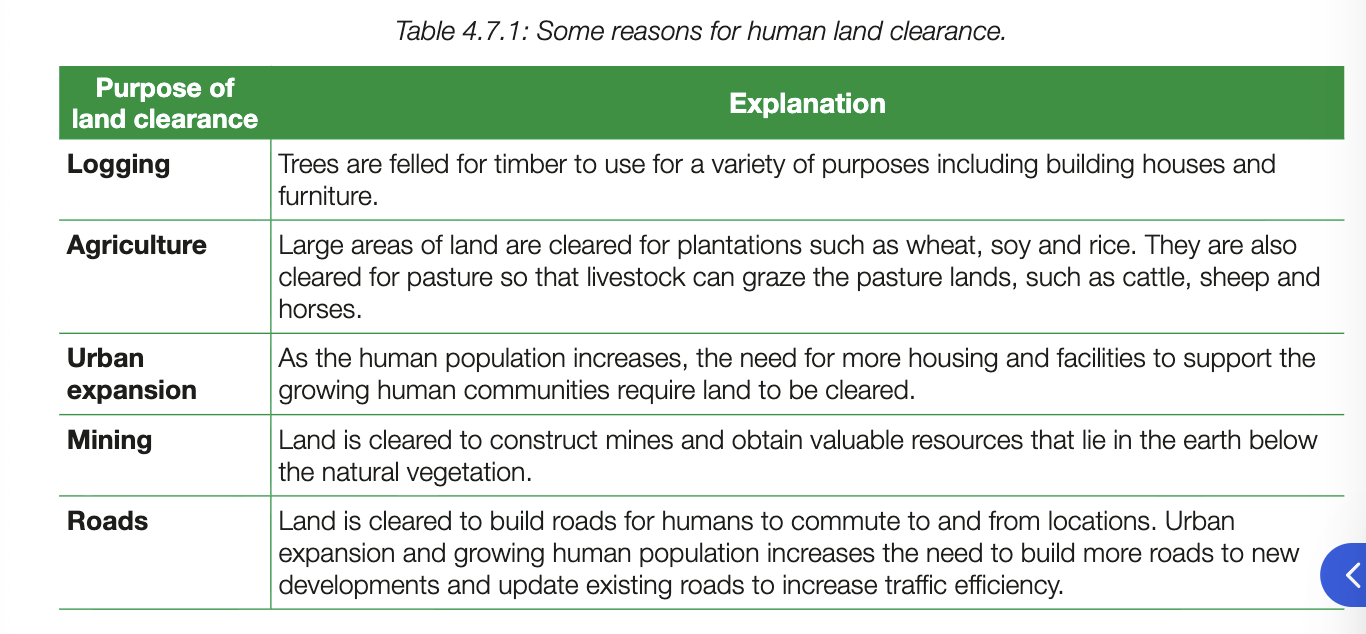
reasons to maintain natural vegetation
provide range of habitats maintaining species diversity
provide vegetation with deep roots which maintian water table levels and prevent soil salinity
help maintain and protect soil from erosion
absorb CO2 (greenhouse gas) and produce O2
help maintain regional rainfall patterns
help reduce no. of weeds and feral animals
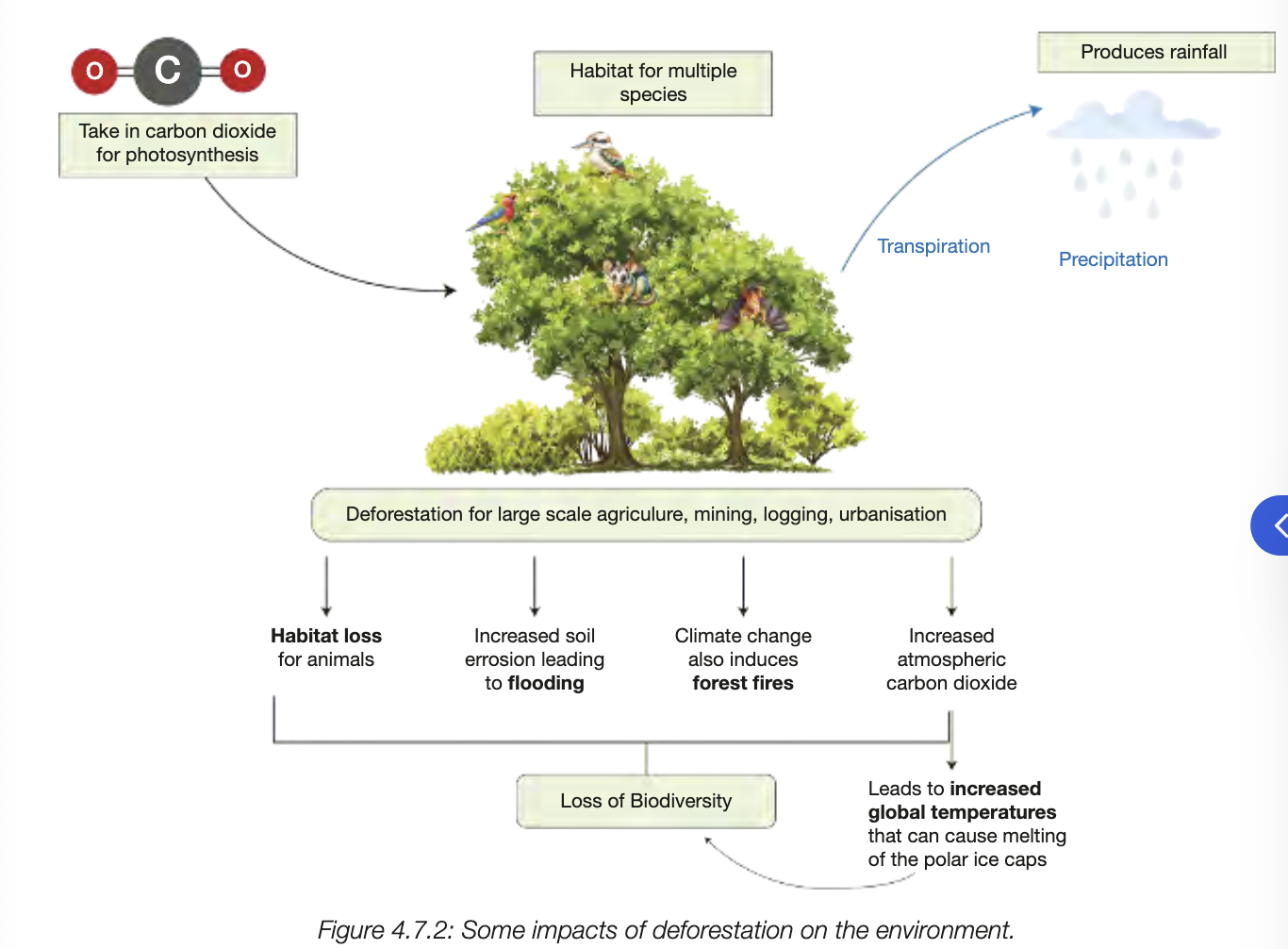
habitat fragmentation (australia specific)
temeprate woodlands most threatened type of ecosystems in aus - 80% cleared
high no of theread native animals and plants
environmental impact of clearing - no old trees mean birds dont have nesting sides, individual species beingg threatened/destroyed means chain reaction affect to biological processes (and food webs)
domestic animals grazing means less food
loss of native grasses means no food - ideal conditions for other species - breaking down remianing woodland habitat
gragmenred patches/islands of native vegetation created - if small, cant sustain important exological processes as effectively
causes decline in species diversity
leads to rise in water table and soil salinity problems when deeprooted plants are gone
introduced species
invasive or extoic
compete with native species for habitat and resoruces or directly feed on them
two species with identical niches cant live togehte rin a community, one will have competitive advantage and survive other extinct
competitive advantages - larger fundemental niche, lack of predators, haster rproduction rates
e.g. feral cats, dogs, foxes, rabbits, pigs, goats, cane toads, camels, rats
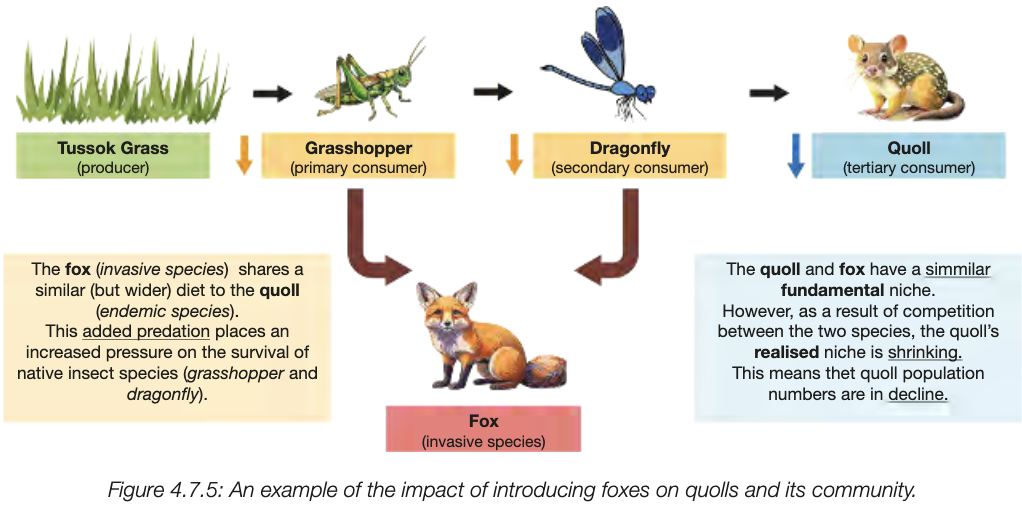
cane toads (ugly mfkers)
native to central and south american countries
introduced in hawaii and bought to QLD to be bilogicla control agents for cane beetles
uncsuccessful biological control - introduced species ate more than just cane beetles
has virtually no natural predators, spread over huge areas of Aus
signigicant impact on biodiversity
predators die after ingesting cane toad because they have poisonous glands on back
feral cats
same species as domestic cats but live and reproduce in wild, survive by hunting or scavenging
introduced by european settlers as pets
produce 3 litters of kittens a year (rapid population increase)
5-23 mil in aus, inhabit 99.8% of australian aldn
kill more than 2.6 billion animals every year
main threat to australian biodiveristy - credible threat to over 200 native species, contribtued to extinctino of more than 20 mammal species already
need to reduce number of them (culling)